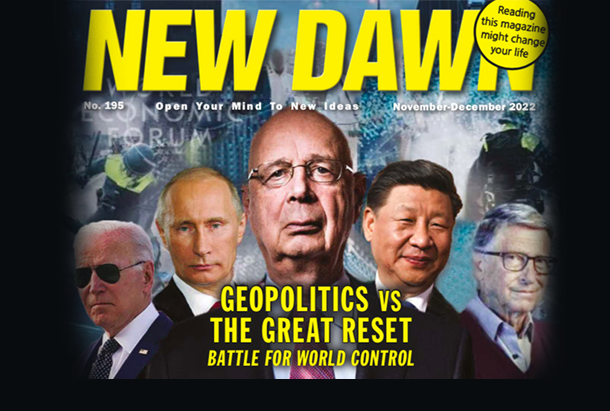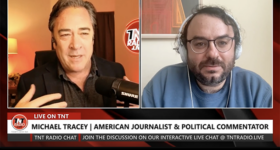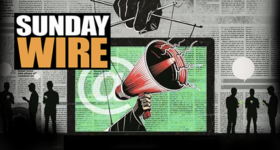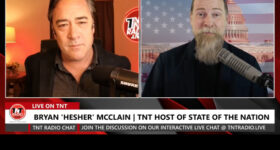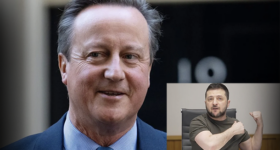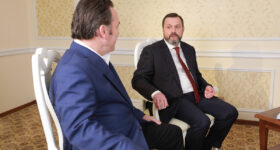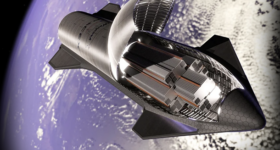The following is an excerpt from the cover story for Issue #195 of New Dawn Magazine…
At some point in the future, we may look back at 2022 as one of the most consequential years of young 21st century history.
This was the year that has shaken the international system to its core, and has possibly brought us closer to the brink of Armageddon than any point since the Cuban Missile Crisis. Indeed, the unthinkable has happened: a major war breaking out on the fringe of Europe, followed the largest combined economic warfare operation in history designed to ‘cancel’ Russia, a country that happens to be the world’s largest overall commodities producer and a nuclear superpower to boot. For the western world, things have gotten pretty tumultuous as a result, with global supply chains fraying at the seams, and with energy, fuel, and food prices continuing to spiral out of control, pushing tens of millions into fuel poverty this winter. As a result, previous assumptions regarding the stability and resilience of modern western advanced economies have now come into question.
Instead of a new world order led by soft power and an ephemeral green solar and wind-powered technocracy, we are suddenly faced with a new reality: hard power has returned to the fore of international relations. We should have seen it coming. After two years of global domestic social and financial upheavals resulting from the COVID-19 pseudo pandemic, geopolitics has come roaring back to retake centre stage in this 21st century epoch. Following Russia’s military intervention in Ukraine, suddenly, the focus immediately shifted away from bio-surveillance, vaccine mandates and the Great Reset – to military formations, and a torrent of western sanctions against Russia. An economic and hyper-inflationary fallout has ensued. Unfortunately for the collective West, this economic war hasn’t ruined Russia in a way that mainstream punditry and politicians hoped it would. The Russian ruble bounced back hitting record highs in recent months, while Russian oil and gas revenues have almost doubled from 2020-2021. Instead, it’s the European and North American economies that have been devastated, with misinformed western consumers mostly miffed as to why they find themselves paying extortionate rates for petroleum, electricity, and gas to run their cars, heat their homes and power their grids. Talk of energy rationing and rolling blackouts have now become the norm throughout the G7 and EU blocs, as they brace themselves for a dark winter. Despite ample evidence to the contrary, politicians and pundits alike are still scapegoating Vladimir Putin for their own precarious economic position.
In general, for western governments, this latest episode has been perhaps the greatest own-goal in history. Rather than change their policy course and work to stabilise global energy and agricultural markets, a gallant virtue-signalling West has instead opted to double down on their precarious stance by further tightening anti-Russian sanctions, as well as pursue even deeper commitments towards de-nulearisation and the not-so-green ‘Net Zero’ carbon reduction agenda. By blocking inbound energy supplies from the Nordstream and other Russian pipelines which supplied them with affordable and reliable gas and oil into the EU, Europe has painted itself into a very perilous corner.
At the core of the European economy is Germany, but if it cannot meet its basic energy requirements at an affordable price, then it will surely spell disaster for both Germany and EU. And that damage will reverberate even further afield. Why would one of the world’s leading economies choose to commit economic suicide? Certainly not merely to support the new face of global victimisation in Ukraine? But it’s not just a case of the western countries making an epic blunder here. Fundamentally, the current economic chaos may also be running its course by design, and appears to meet many of the preconditions for Klaus Schwab’s infamous Great Reset agenda. We’re talking here about the deindustrialisation of the West, all in the name of reaching their UN Sustainable Development Goals, supposedly in order to save the world from the scourge of climate change.
The Atlanticists’ Real Target: Germany
To fully understand what is happening in Europe, Ukraine, Russia and North America – and why, one must take into account the historical period known as the interwar period which preceded the Second World War, and the American-led liberal internationalist world order which followed it. Understanding this important phase in globalisation will help us see past the well-worn western talking point which claims that the current calamity is all about ‘Russia’s war of aggression’, and that the North Atlantic Treaty Alliance (NATO) is a benign defensive organisation and the last bulwark against the imperialist Russian hoards overrunning Europe from the east. Rather, what we are witnessing is the continuation of long-range policy of the Anglo-American establishment designed to tame Germany – both economically and geopolitically – and thus to prevent Europe from building trade and political links with Eurasia (ie. the Great Game 2.0).
Much has been made of the fact that NATO members have reneged on previous promises not to expand eastward, but this fact alone does not reveal the full scope of NATO’s task and purpose. Documents from the U.S. National Security Archive clearly show how in 1990 the Soviet leader Mikhail Gorbachev had in fact agreed to German reunification with the West in part due to assurances made by U.S. envoy James Baker that NATO would not expand to encircle Russia. “Not one inch eastward” was Baker’s famous pronouncement. There were other such verbal and diplomatic assurances made by the West over the years, but nothing was ever formalised in a written treaty or accord. This aspect of the story is only part of a much larger geopolitical equation.
One of the biggest myths in modern western narrative is the belief that reason NATO exists is to protect and defend Europe from the former Soviet, and now Russian, threat from the east. In reality, the true nature of NATO was revealed by its first Secretary General, Britain’s Lord Hastings Lionel Ismay, who famously quipped that the purpose of the alliance was “to keep the Russians out, the Americans in, and the Germans down.” In essence, this was, and still is the main Anglo-American objective in their management of European affairs. A key part of the post WWII arrangement for Europe was that the United States and its allies would provide the security for Europe, and that countries like Germany ‘would not be burdened’ with having to maintain a national military and could then focus on their economic development as part of the largest project of rebuilding a post-war Europe which was organised through the U.S. Marshall Plan. In return for their cooperation, German industry was then given unfettered access to a new and burgeoning U.S. consumer market. This very same ‘peace dividend’ was also adopted for post-war Japan…
Read the full special feature in Issue #195 of New Dawn Magazine
READ MORE UKRAINE NEWS AT: 21st Century Wire Ukraine Files
PLEASE HELP SUPPORT OUR INDEPENDENT MEDIA PLATFORM HERE
ALSO JOIN OUR TELEGRAM CHANNEL


